Imagine the tantalizing aroma of sizzling meats, the symphony of crackling flames, and the anticipation of that perfect sear—now picture achieving all of this without a traditional grill.
Yes, you read that right! While the grill may be the quintessential symbol of backyard gatherings, there’s a world of culinary magic awaiting those who dare to think outside the grill marks.
From impromptu indoor setups to innovative outdoor alternatives, mastering the art of grilling without a grill opens up a realm of possibilities for culinary creativity and adventure.
So, whether you’re a city dweller with limited space or simply looking to broaden your BBQ horizons, prepare to embark on a journey where the only limit is your imagination. It’s time to fire up your culinary ingenuity and discover the secrets of grilling without a grill!
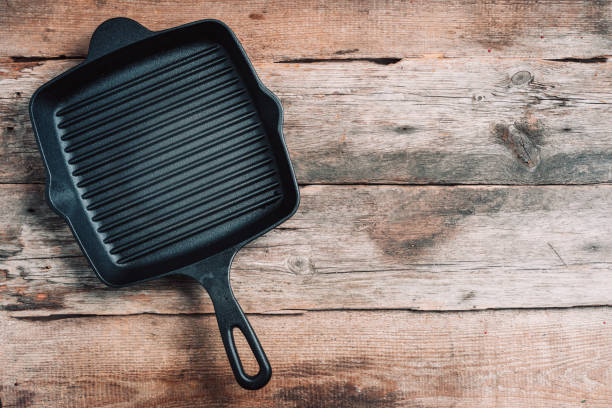
How To Grill Without A Grill
Grilling without a grill is possible with alternative methods that replicate the smoky, charred goodness of traditional BBQ. From stovetop grilling to using a broiler or oven, there are several techniques to achieve delicious grilled dishes indoors.
Stovetop Grilling Techniques
When lacking a grill, your stovetop becomes your best friend for grilling. Opt for a grill pan or a cast-iron skillet to achieve those coveted grill marks. Preheat the pan over medium-high heat and lightly oil it to prevent sticking. Place your seasoned meat, vegetables, or even fruits on the hot surface and cook until charred to perfection.
Broiling for That Charred Finish
Broiling is an effective method to mimic the intense heat of a grill. Preheat your broiler and place your food on a broiler pan or a baking sheet lined with foil. Position the rack close to the broiler element for optimal heat. Keep a close eye on your food as it broils to avoid burning, and flip halfway through for even cooking.
Harnessing the Power of the Oven
The oven can be a versatile tool for grilling indoors. Use a roasting pan or a wire rack set over a baking sheet to elevate your food and allow for proper air circulation. Set the oven to a high temperature and use the broil setting if available for that characteristic char. Rotate your food halfway through cooking for uniform browning.
Adding Smoky Flavor
While grilling indoors, you may miss out on the signature smokiness of outdoor grilling. Enhance your dishes with liquid smoke, smoked paprika, or chipotle powder to impart that sought-after smoky flavor. Marinating your ingredients beforehand can also infuse them with depth and complexity.
Grilling without a grill doesn’t mean sacrificing flavor or texture. With these inventive techniques, you can enjoy the essence of BBQ year-round, regardless of the weather or equipment constraints. Experiment with different methods and flavors to discover your perfect indoor grilling repertoire.
Important Properties Of A Grill Pan
A grill pan is a versatile kitchen tool that offers numerous advantages for cooking enthusiasts. One of its crucial properties is its ability to mimic the outdoor grilling experience indoors.
Equipped with raised ridges, a grill pan creates beautiful grill marks on food, enhancing its visual appeal. These ridges also serve a functional purpose by allowing excess fat to drain away from the food, resulting in healthier meals.
Another vital property of a grill pan is its even heat distribution, ensuring that food cooks uniformly. This feature is particularly beneficial for searing meats or grilling vegetables to perfection.
Most grill pans are constructed from durable materials such as cast iron or hard-anodized aluminum, guaranteeing longevity and resilience to high heat.
With its capacity to impart delicious smoky flavors and provide excellent heat retention, a grill pan is an indispensable tool for achieving restaurant-quality results in the comfort of one’s kitchen.
3 Common Materials Of A Grill Pan
Grill pans are available in various materials, each offering distinct advantages. Three common materials used in the construction of grill pans are cast iron, ceramic, and aluminum.
Cast Iron
Cast iron is a classic and popular material for grill pans due to its exceptional heat retention and distribution properties. These pans are prized for their ability to create beautiful sear marks on food while ensuring even cooking throughout.
Cast iron grill pans are incredibly durable and can withstand high temperatures, making them suitable for use on various heat sources, including stovetops, ovens, and even grills. With proper seasoning and care, cast iron develops a natural non-stick surface, which improves over time, enhancing cooking performance and flavor.
While cast iron grill pans may require a bit of maintenance, such as regular seasoning and avoiding harsh detergents, their longevity and versatility make them a favorite among cooking enthusiasts.
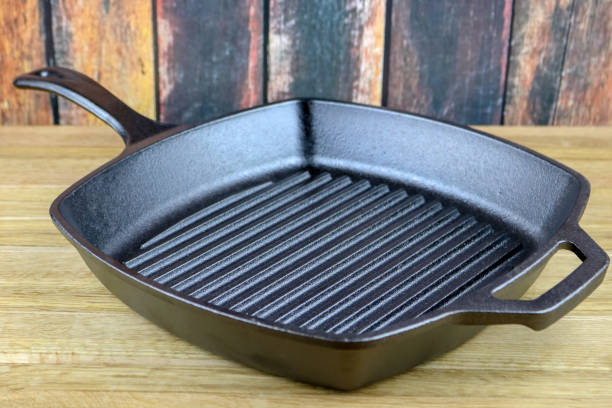
Aluminum
Aluminum is another common material used in grill pans, prized for its excellent heat conduction properties. Grill pans made from aluminum heat up quickly and evenly, ensuring consistent cooking results.
They are also lightweight, making them easy to handle and maneuver on the stove or grill. Aluminum grill pans often feature non-stick coatings, which facilitate easy food release and cleanup, reducing the need for excess oil or butter during cooking.
These pans are typically more affordable than cast iron or stainless steel options, making them a popular choice for budget-conscious consumers.
However, aluminum grill pans may not retain heat as effectively as other materials, requiring closer attention to prevent food from burning or sticking. Despite this, their efficient heat conduction and affordability make them a practical and versatile option for everyday grilling needs.
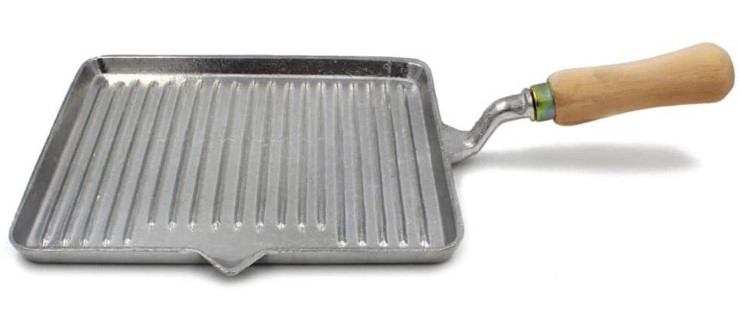
Ceramic
Ceramic grill pans offer a modern twist on traditional grilling cookware, featuring a non-stick ceramic coating that provides a smooth cooking surface and easy food release. These pans are known for their attractive appearance, often available in a variety of vibrant colors and stylish designs.
Ceramic grill pans heat up relatively quickly and distribute heat evenly, allowing for uniform cooking and consistent results. The non-stick coating reduces the need for excessive oil or butter, promoting healthier cooking practices and simplifying cleanup.
Ceramic grill pans are lightweight and easy to handle, making them suitable for everyday use. However, it’s essential to handle ceramic grill pans with care to prevent scratching or damaging the delicate coating.
While they may not offer the same level of durability as cast iron or stainless steel pans, ceramic grill pans provide a convenient and stylish option for those seeking non-stick cooking performance with a contemporary flair.
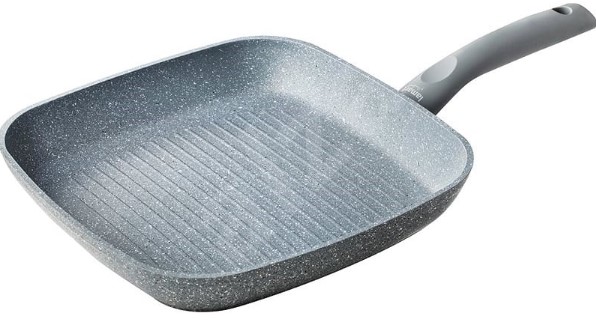
Size and Shapes
Grill pans come in various sizes and shapes to accommodate different cooking needs and preferences.
- Size: Grill pans can range from compact options suitable for single servings or small portions to larger pans capable of cooking for a crowd. Smaller grill pans are ideal for cooking individual items like steaks, chicken breasts, or vegetables, while larger pans can handle multiple servings or larger cuts of meat. The size of the grill pan should be chosen based on the amount of food you typically cook and the available space on your stovetop or grill.
- Shapes: Grill pans are commonly available in square or rectangular shapes, mimicking the appearance of outdoor grills. These shapes provide ample cooking surface area and allow for efficient use of space on the stovetop or grill. Some grill pans feature round shapes, which can be suitable for specific dishes or for fitting into round stovetop burners. Specialty shapes such as oval or ribbed designs may also be available, catering to specific cooking needs or preferences. Ribbed grill pans, for example, create attractive grill marks on food and allow excess fat to drain away, resulting in healthier meals.
Ultimately, the choice of size and shape depends on individual cooking requirements, kitchen space, and personal preferences. Whether you’re cooking for yourself or a large gathering, there’s likely a grill pan size and shape that suits your needs.
What Can You Use Instead Of A Grill Pan?
If you don’t have a grill pan, there are several alternatives you can use to achieve similar results:
Cast Iron Pan
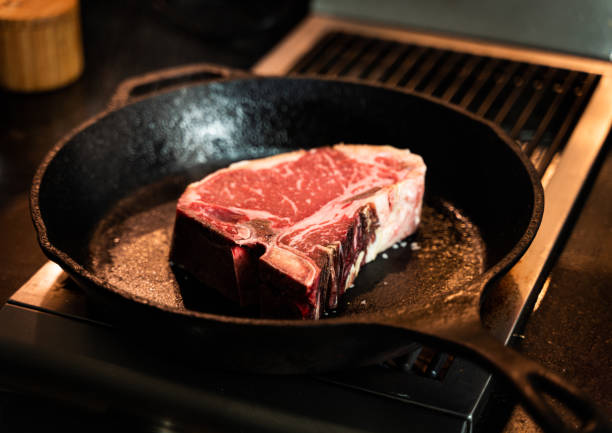
A cast iron pan is an excellent alternative to a grill pan. While it doesn’t have the raised ridges for grill marks, it can still deliver deliciously seared food with a nice caramelized exterior. To use a cast iron pan for grilling, preheat it over medium-high heat until it’s hot.
Then, add a small amount of oil to the pan and place your food in it. Let the food sear without moving it too much to ensure proper browning. Flip the food halfway through the cooking process to ensure even cooking on both sides.
The cast iron’s excellent heat retention properties will help create a beautifully seared exterior while keeping the interior juicy and tender.
Frying pan
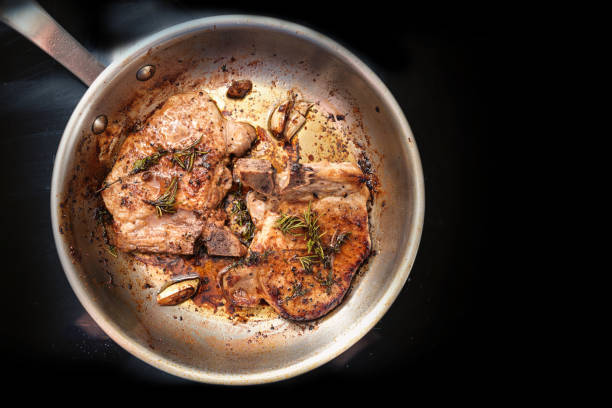
A frying pan can also serve as a makeshift grill pan when you’re in a pinch. While it lacks the raised ridges, you can still achieve a nice sear and caramelization on your food. To use a frying pan for grilling, preheat it over medium-high heat until it’s hot.
Add a small amount of oil to the pan to prevent sticking, then place your food in the pan. Allow the food to cook without moving it too much to ensure proper browning.
Flip the food halfway through the cooking process to ensure even cooking on both sides. While you won’t get the same grill marks as with a grill pan, a frying pan can still help you achieve deliciously grilled dishes indoors.
Aluminum Foil
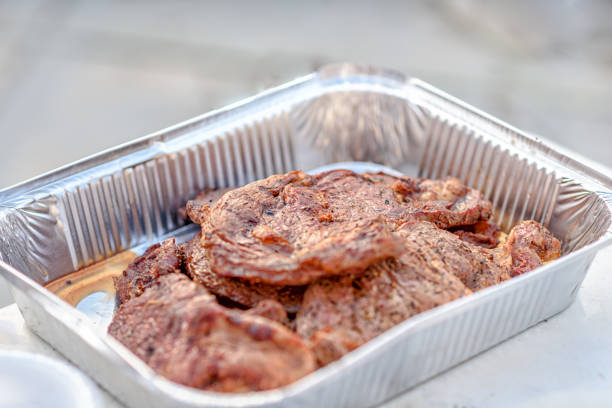
Aluminum foil can be a creative solution for grilling indoors when you don’t have access to a grill pan or outdoor grill. This method is commonly referred to as “grilling in foil packets” or “foil packet cooking.”
To grill using aluminum foil, start by tearing off a large sheet of foil and folding it in half to create a double layer. Place your desired ingredients, such as meat, vegetables, and seasonings, in the center of the foil.
Fold the edges of the foil over the ingredients and seal them tightly to form a packet, ensuring no juices or steam can escape during cooking. Preheat your oven to the desired temperature or heat a stovetop burner to medium-high heat.
Place the foil packet directly onto the oven rack or onto a baking sheet or stovetop griddle. Cook the packet for the appropriate amount of time, flipping it halfway through if necessary to ensure even cooking.
The foil will trap steam and heat, effectively “grilling” the ingredients inside the packet while infusing them with flavor. This method is versatile and allows for easy cleanup since there’s no pan to wash afterward.
Sheet Pan
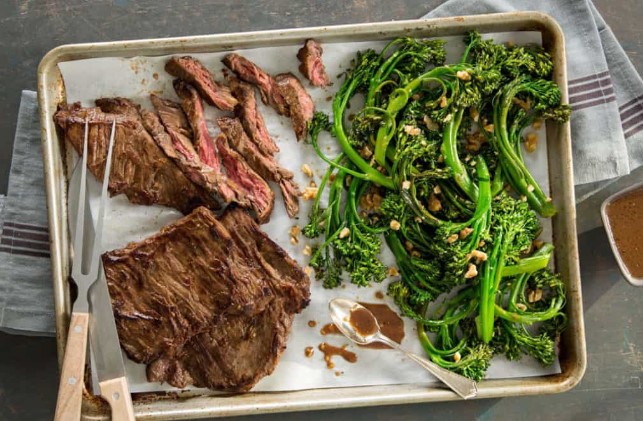
Using a sheet pan for grilling indoors can be a convenient alternative to a grill pan. While it doesn’t provide the same direct contact with heat or grill marks, it’s excellent for cooking larger quantities of food at once.
To use a sheet pan for grilling, preheat your oven to a high temperature, typically around 400-450°F (200-230°C). Arrange your ingredients, such as chicken breasts, vegetables, or kebabs, on the sheet pan in a single layer.
Drizzle with oil and seasonings to add flavor. Place the sheet pan in the preheated oven and cook the ingredients until they are cooked through and nicely browned, flipping halfway through the cooking time to ensure even cooking.
The high heat of the oven will help create caramelization and a delicious roasted flavor. While you won’t get the same grill marks as with a grill pan, using a sheet pan is a convenient way to enjoy grilled-style dishes indoors with minimal cleanup.
Things To Know When Grill Without Grill Pan
Grilling without a grill pan requires some adjustments, but it’s entirely feasible and can produce delicious results. Here are some essential things to know when grilling without a grill pan:
Choose the Right Cooking Surface
When grilling without a grill pan, selecting the appropriate cooking surface is crucial. Opt for cookware that can withstand high heat and promote even cooking. Cast iron skillets, stainless steel pans, and griddle plates are excellent choices.
These materials distribute heat evenly and allow for proper searing, ensuring your food cooks evenly and develops desirable flavors. Ensure the cooking surface is clean and adequately preheated before adding your ingredients to achieve optimal results.
Preheat Properly
Preheating your cooking surface properly is essential when grilling without a grill pan. Whether you’re using a skillet, griddle, or any other cooking surface, preheating ensures even cooking and helps to achieve that desirable sear on your food.
Allow your cooking surface to heat up thoroughly before adding your ingredients. This not only helps to prevent sticking but also promotes caramelization and enhances the flavor of your grilled dishes.
Depending on the cooking surface and the type of food you’re grilling, preheat it over medium to medium-high heat for a few minutes to ensure it’s adequately heated before you start cooking.
Oil the Surface
Before placing your food on the cooking surface, it’s essential to oil it properly, especially when grilling without a grill pan. This helps to prevent sticking and promotes even cooking.
Use an oil with a high smoke point, such as vegetable oil, canola oil, or grapeseed oil, as they are less likely to burn at high temperatures. To oil the surface, you can either brush it lightly with oil or use a paper towel to spread a thin layer across the surface.
Be sure not to use too much oil, as it can lead to excess smoke and flare-ups. Properly oiled surfaces ensure that your food cooks evenly and develops a delicious crust without sticking to the cooking surface.
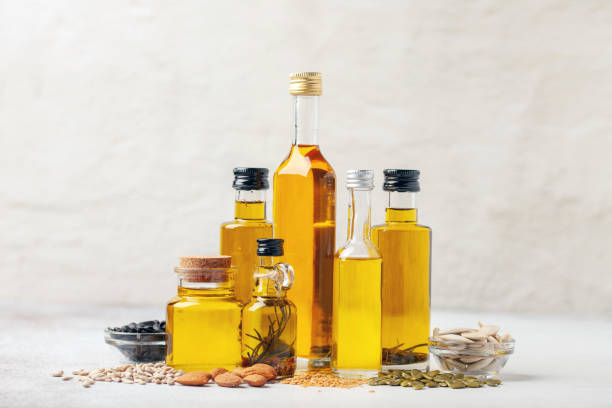
Mind the Smoke
When grilling without a grill pan, it’s important to be mindful of the potential for smoke, especially if you’re cooking at high temperatures or using oil.
Open windows and turn on ventilation fans to help dissipate smoke and prevent it from accumulating in your kitchen. Additionally, consider using oils with higher smoke points, such as vegetable oil or grapeseed oil, to minimize the risk of smoke production.
If you notice excessive smoke while cooking, reduce the heat slightly or adjust your cooking method to mitigate it. Being aware of smoke levels ensures a more pleasant cooking experience and helps prevent setting off smoke alarms.
Don’t Crowd the Pan
To ensure proper cooking and optimal results when grilling without a grill pan, avoid overcrowding the cooking surface. Overcrowding can lead to uneven cooking, steaming instead of searing, and longer cooking times.
To prevent this, arrange your ingredients in a single layer on the cooking surface, leaving some space between each piece. This allows heat to circulate evenly around the food, ensuring that it cooks thoroughly and develops a delicious crust.
If you have a large quantity of food to cook, consider cooking in batches rather than trying to cook everything at once. This ensures that each piece has enough space to cook properly and results in better-tasting grilled dishes.
Flip Carefully
When grilling without a grill pan, it’s crucial to flip your food carefully to ensure even cooking and prevent sticking or breaking apart. Use a spatula or tongs to gently lift and turn each piece of food, being mindful not to forcefully scrape or tear it.
Allow the food to cook on one side until it develops a golden-brown crust before flipping it to the other side. Avoid flipping the food too frequently, as this can interfere with the development of the desired sear and crust.
Additionally, if you’re grilling delicate items such as fish or vegetables, handle them with extra care to prevent them from falling apart. By flipping your food carefully, you’ll achieve beautifully grilled dishes with intact and perfectly cooked ingredients.
Adjust Cooking Times
When grilling without a grill pan, it’s essential to adjust cooking times to accommodate the specific cooking surface and heat source you’re using. Different cooking surfaces conduct heat differently, so you may need to modify your cooking times accordingly.
Keep in mind that thicker cuts of meat or larger vegetables will generally require longer cooking times, while thinner cuts or smaller pieces will cook more quickly.
Factors such as the intensity of the heat source and the desired level of doneness will also influence cooking times. To ensure that your food is cooked to perfection, regularly check for doneness by using a meat thermometer for meats or testing vegetables with a fork.
Adjusting cooking times as needed ensures that your grilled dishes are cooked evenly and reach the desired level of doneness.
Get Creative
Grilling without a grill pan opens up a world of creative possibilities in the kitchen. Don’t be afraid to experiment with different ingredients, seasonings, and cooking techniques to create unique and flavorful dishes.
Try marinating meats or vegetables in your favorite sauces or spice blends before grilling to infuse them with delicious flavor. You can also explore different grilling methods, such as using skewers for kebabs, wrapping food in foil packets for a moist and flavorful result, or even grilling fruits for a sweet and smoky dessert.
Consider incorporating a variety of herbs, spices, and aromatics to enhance the taste of your grilled dishes. With a bit of creativity and experimentation, you can transform ordinary ingredients into extraordinary grilled masterpieces that will impress your family and friends.
Cleaning The Grill Pan Substitutes
Cleaning grill pan substitutes, such as cast iron skillets, frying pans, or sheet pans, is essential to maintain their performance and longevity. Here’s how to clean them effectively:
Cleaning Cast Iron
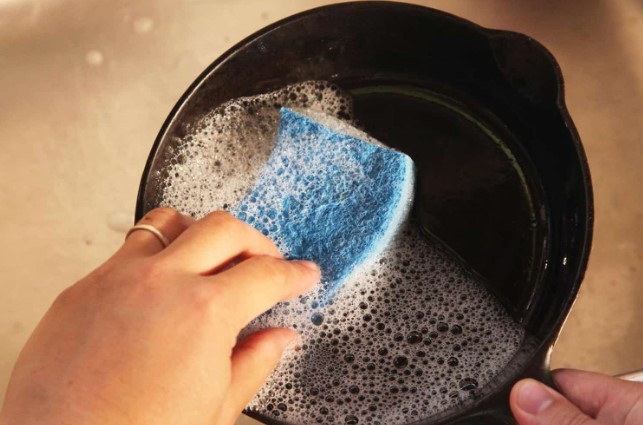
Cleaning cast iron cookware, such as a grill pan, requires special care to maintain its seasoning and prevent rusting. After each use, allow the cast iron grill pan to cool down completely.
Then, use a stiff brush or scraper to remove any food residue or stuck-on bits. Avoid using soap or harsh detergents, as they can strip away the pan’s seasoning. Instead, rinse the pan under hot water and scrub it with a brush or sponge.
For stubborn residue, you can use coarse salt as a gentle abrasive. Once clean, thoroughly dry the pan with a towel to prevent rust. To maintain the seasoning, you can apply a thin layer of cooking oil to the entire surface of the pan while it’s still warm.
Store the pan in a dry place, and avoid stacking other items on top of it to prevent damage to the seasoning. With proper care, your cast iron grill pan will develop a natural non-stick surface and provide years of reliable use.
Cleaning Frying Pan
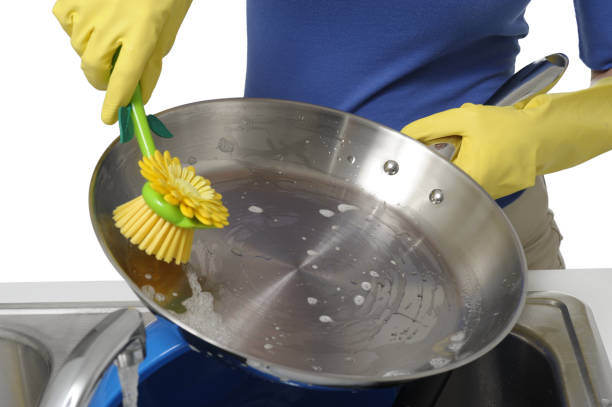
Cleaning a frying pan thoroughly ensures its longevity and continued performance. After each use, allow the pan to cool down before cleaning to avoid burns and warping. Use a spatula or scraper to remove any food residue or stuck-on bits from the cooking surface.
If there are stubborn stains, you can soak the pan in warm, soapy water to loosen them before scrubbing. Avoid using abrasive scrubbers or steel wool, as they can scratch the surface of the pan. Instead, use a soft sponge or cloth to gently scrub the pan clean.
Rinse the pan thoroughly with warm water to remove any soap residue. For tough stains, you can use a paste made of baking soda and water to scrub the pan gently. Once clean, dry the frying pan thoroughly with a clean towel to prevent water spots and rust.
Store the pan in a dry place to maintain its condition. Regular cleaning and proper maintenance will ensure that your frying pan remains in good condition and ready for your next cooking adventure.
Cleaning Sheet Pan
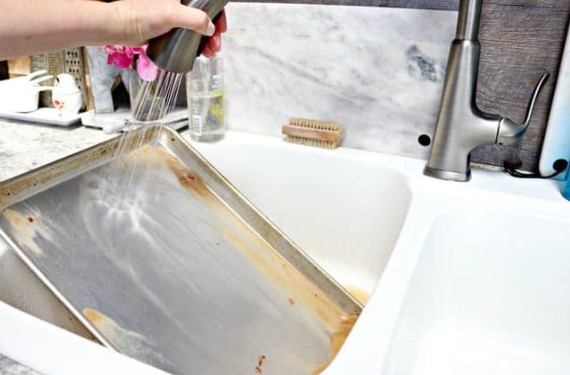
Cleaning a sheet pan effectively is crucial for maintaining its condition and ensuring its longevity. After each use, allow the sheet pan to cool down before cleaning to prevent burns.
Use a spatula or scraper to remove any food residue or stuck-on bits from the surface of the pan. If there are stubborn stains, you can soak the sheet pan in warm, soapy water to loosen them before scrubbing.
For tough stains, you can also create a paste using baking soda and water and apply it to the affected areas. Use a soft sponge or brush to scrub the pan gently, focusing on areas with stubborn stains.
Rinse the sheet pan thoroughly with warm water to remove any soap residue. If there are any lingering odors, you can sprinkle the pan with baking soda and let it sit for a few hours before rinsing it again.
Once clean, dry the sheet pan thoroughly with a clean towel to prevent water spots and rust. Store the sheet pan in a dry place to maintain its condition and avoid stacking other items on top of it to prevent scratches.
Regular cleaning and proper maintenance will ensure that your sheet pan remains in good condition and ready for your next baking or cooking task.
How To Make Grill Marks When Using A Grill Pan Substitute?
Creating grill marks when using a grill pan substitute, such as a cast iron skillet or a frying pan, is achievable with a few simple techniques:
- Preheat the Pan: Ensure that your cooking surface is thoroughly preheated before adding your food. This step is crucial for achieving those desirable sear marks. Preheat your skillet or pan over medium-high to high heat for several minutes until it’s hot enough to sear the food.
- Oil the Food, Not the Pan: Instead of oiling the pan, lightly brush or drizzle oil directly onto the food you’re cooking. This helps to create a barrier between the food and the cooking surface, allowing it to sear and develop grill marks more effectively.
- Place Food Diagonally: To create diagonal grill marks, place your food on the preheated grill pan at a 45-degree angle to the ridges or lines. This positioning ensures that the food makes direct contact with the ridges, resulting in distinct grill marks.
- Avoid Moving the Food: Once you’ve placed the food on the grill pan, resist the urge to move it around too much. Let it sear and develop grill marks for a few minutes without disturbing it. Moving the food prematurely can disrupt the grill marks and prevent them from forming evenly.
- Rotate the Food: After a few minutes of cooking, gently rotate the food 90 degrees using tongs. This rotation helps to create a crosshatch pattern and ensures that the grill marks are evenly distributed across the surface of the food.
- Flip and Repeat: Once the first side of the food has developed grill marks to your liking, flip it over using tongs and repeat the process on the other side. Remember to brush or drizzle oil on this side of the food as well.
By following these simple steps, you can achieve beautiful grill marks on your food when using a grill pan substitute, adding visual appeal and a touch of outdoor grilling flavor to your dishes.
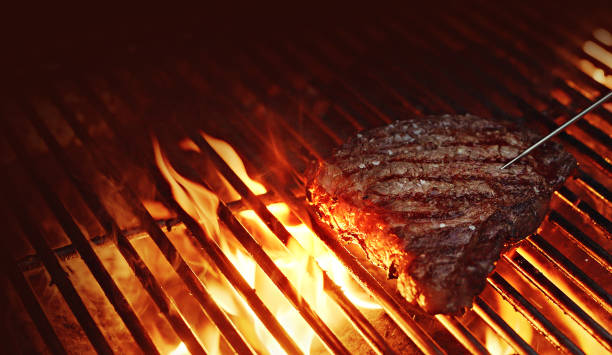
Frequently Asked Questions (FAQs) – How To Grill Without A Grill
What creative alternatives can I use for grilling if I don’t have a grill?
Discover a plethora of inventive methods ranging from stovetop grilling to using a cast-iron skillet or even a panini press to achieve that perfect grilled flavor indoors!
How can I replicate the smoky taste of grilled food without an outdoor grill?
Unveil the secrets of infusing your dishes with that irresistible smokiness using techniques like stovetop smoking or incorporating smoked ingredients such as smoked paprika or liquid smoke.
Are there any innovative ways to grill vegetables without a traditional grill?
Explore exciting techniques like broiling, roasting, or even utilizing a grill basket on your stovetop to elevate the flavors and textures of your favorite veggies, creating delectable dishes without the need for an outdoor grill.
Can I achieve perfectly grilled meats without a barbecue grill?
Absolutely! Learn how to achieve beautifully seared and tender meats using methods like using a broiler, a grill pan, or even employing the sous vide technique before finishing with a quick sear for that authentic grilled taste.
How can I ensure my indoor grilling experience is safe and hassle-free?
Dive into a comprehensive guide on indoor grilling safety tips, including proper ventilation techniques, selecting the right cookware, and maintaining optimal cooking temperatures to enjoy a worry-free grilling experience indoors.
Are there any unexpected kitchen gadgets that can mimic the grilling experience?
Explore unconventional yet effective tools like a culinary blowtorch or a Japanese-style konro grill to replicate the char and caramelization typically achieved on a traditional barbecue grill, adding a unique twist to your indoor cooking adventures.
What are some inventive recipes I can try for indoor grilling?
Unlock a treasure trove of mouthwatering recipes tailored for indoor grilling, ranging from juicy burgers and succulent kebabs to flavorful grilled pizzas and tantalizing grilled fruit desserts, ensuring every meal is a delightful culinary adventure.
How can I infuse my indoor grilled dishes with diverse flavors and aromas?
Embark on a flavor-filled journey by exploring marinades, rubs, and spice blends tailored for indoor grilling, allowing you to customize your dishes with an array of tantalizing flavors and aromatics that will leave your taste buds wanting more.
Can I grill seafood indoors without compromising on taste and texture?
Delve into techniques such as pan-searing, grilling on a cedar plank, or using a stovetop grill pan to achieve perfectly cooked seafood with a delightful smoky flavor, ensuring your indoor grilling experience is as satisfying as cooking outdoors.
How can I adapt traditional grilling recipes for indoor cooking without sacrificing authenticity?
Discover clever adaptations and cooking hacks to transform your favorite outdoor grilling recipes into indoor-friendly delights, ensuring that every dish retains its authenticity and flavor profile, regardless of the cooking environment.
Conclusion
In conclusion, mastering the art of grilling without a traditional grill opens up a world of culinary possibilities, regardless of your living situation or access to outdoor space.
Through innovative techniques such as stovetop grilling, using a grill pan, or utilizing alternative appliances like a broiler or a smoker, one can achieve deliciously charred flavors and succulent textures reminiscent of traditional grilling.
Moreover, exploring creative marinades, seasonings, and cooking methods allows for endless experimentation and culinary creativity.
By adapting to the resources at hand and embracing inventive approaches, anyone can enjoy the thrill of grilling and elevate their cooking prowess to new heights.
So, whether you’re grilling in a small apartment or seeking alternatives during inclement weather, the journey to becoming a grill master is within reach, offering flavorful experiences and culinary satisfaction for all.